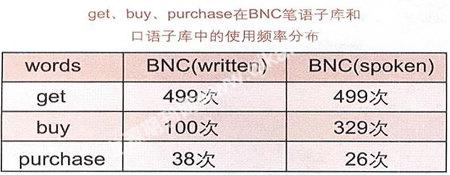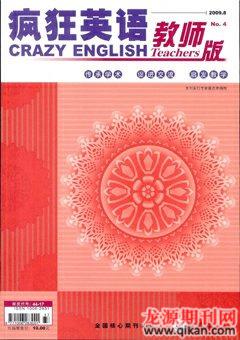基于语料库的英语近义词辨析
陆丽华
摘 要:随着语料库技术的不断发展,语料库的应用越来越广泛。文章概述了基于语料库的英语近义词辨析:词义、语义韵、语体以及在教学上的应用。作者认为基于语料库的英语近义词辨析是迅速掌握英语近义词行之有效的方法。
关键词:近义词;辨析;语料库
[中图分类号]H030
[文献标识码]A
[文章编号]1006-2831(2009)08-0103-4
Abstract: With its rapid development in technology, corpus is widely used in English teaching. This paper mainly introduces how to distinguish synonyms in terms of meaning, semantic prosody, style and the teaching application. The author believes corpus-based study is effective to help learning of synonyms easier.
Key words: synonyms, discrimination, corpus
1. 引言
现代语料库语言学(modern corpus linguistics)是20世纪中后期兴起的一门语言研究科学。语料库是指在随机采样的基础上收集的、有代表性的真实语言材料的集合,是语言运用的样本(杨惠中,2002:9)。它以其容量大、语料真实、检索快捷准确等独特的优势在现代语言学研究和语言教育等领域发挥着越来越重要的作用。词汇学习是外语学习中的一个重要组成部分,直接影响到一个人的语言交际能力。Wilkins(1972: 111)的名言——“没有语法只能传达很少的信息,没有词汇则什么也无法传达”足以证明词汇学习的重要性。在多年的英语词汇教学中,笔者发现学生对于近义词的辨析颇感困惑,教师凭借词典简单地呈现例句或者凭经验来分析词汇的异同点往往是片面的、不可靠的。而语料库可以帮助学习者获得包含某一检索词的很多鲜活例子,通过大量真实语境的出现,让学习者体会、发现、归纳近义词的异同,揭示特征,掌握规律,巩固深化。
2. 基于语料库的英语近义词辨析方法
2.1 运用近义词的搭配进行词义辨析
英语中有着丰富的近义词,它们虽然意思相近,但是在语意、语用等方面仍然存在差异。弄清差异有助于理解词语的内涵,利用这些差异有助于增强语言的表达效果。近义词大致可以分两种:绝对近义词(Complete Synonyms)和相对近义词(Relative Synonyms),英语中更多的是相对近义词。搭配(collocation)是指词语经常一起使用的表达形式,体现的是词语之间的具有典型性的共现现象,是基于语料库的词汇研究中最为活跃的部分。如和“pretty”经常搭配的词有:“girl”、“woman”、“flower”、“garden”、“color”、“village”等;和“handsome”经常搭配的词有:“boy”、“man”、“car”、“vessel”、“overcoat”、“airliner”、“typewriter”等。笔者对“stage”和“period”两词进行了比较。根据《英汉大词典》(陆谷孙,1993:1825,1347),这两个词都有“阶段”、“时期”的含义。通过运用语料库的检索,可引导学习者观察近义词的搭配,在真实的语境下发现它们之间的细微差别。
(1) operating conditions in the first stageand always using the optimal **f-st
(2) both before and after this crucial stage;and maximum length, with confirmation
(3) are m operating variables at each stage and that the state is specified by
(4) put E (in the case of the second stage,for the first phosphor screen emission
(5) which considers culture as a third stagein biological evolution fits quite
(6) ain so well at a relatively early stage in the evolutionary scheme, tended
(7) by two actors of the contemporarystage. In the field of entertainment
(8) resolution limitations for a single stage are given by the inherent resolution
(9) can only be expected in the final stage of an image intensifier at rather
(10) prepare the human race for its next stage of development, an eventual merging
(11) be to assure that movement into astage of self-sustaining growth is not prevented
(12) transformation may be effected in the first stage of an R-stage process, the remaining
(13) interpret them as an apogee of the first stage of Greek civilization. On this
(14) SOURCES OF DATA:_The first stage of operation has centered on the
“stage”一词在Brown语料库中出现了190次,说明使用频率较高。在以上提取的14条索引行中,该词除了“舞台”词义外,大部分的意义为“阶段、时期”。
从以上典型例子中发现:“stage”前面常出现序数词,如“first”、“second”、“third”等;前面与其相搭配的形容词为“crucial”、“each”、“early”、“contemporary”、“single”、“final”等;该词后经常跟随“of+名词”的结构,如“development”、“growth”、“process”、“civilization”、“operation”等。笔者进一步深入提取该词所属语境资料,以下语篇为第(6)条索引行中“stage”所在语境:
(6) of adaptation and defense that are just too complete and too satisfactory. Mollusks are a case in point. The shell, which served the strain so well at a relatively early stage in the evolutionary scheme, tended to cancel out the possibility of future development. Though this may or may not be good biology, it does aptly illustrate the strength and the weakness of American Catholic.
在该语境中,“stage”是指“发展的进程,阶段或时期”,着重于事物的演变发展。
再来观察下面索引行中“period”的用法。“period”一词在Brown语料库中出现265次,使用更为频繁。从提取的索引行中发现:“period”前有“the”、“this”、“that”出现;修饰的词为“long”、“same”、“considerable”、“short”、“brief”、“10-year”等;该词后面也有“of+名词”结构,出现最多的为“time”、“year”、“illness”、“report”等。分析该词所处语境后发现,“period”为“一段时间、时期”,着重于从开始到结束。查阅有关资料,“period”来源于希腊语的“periodus”,意思是“周期,循环”,“period”至今仍保留着这层意思。笔者进一步查阅在语料库基础上编纂的COBUILD英汉双解词典(柯林斯伯明翰大学国际语料库)(辛克莱,2002:1432,1900),“period”的解释为“一段时间,期间,(历史上)时代,时期”;“stage”的解释为“(连续过程中的某个)时期,阶段,(有若干阶段的发展过程中的某个)阶段”,与本研究结果相符。
(1) slide sets. _2._ During this period, a total of 762 exhibits were presented
(2) political account. Finally, the period after 1870 receives little attention
(3) and extend over a much shorterperiod, approximately 30 months for boys
(4) he the only animal who has a longperiod after the decline of his procreativity
(5) only 122,158. Yet during the sameperiod there were 1,080,062 additions.
(6) but not to exceed such twelve-year period, the Secretary shall proceed as
(7) held open for her for a considerable period. But she decided to stay at Spelman
(8) space on the planet. For a brief period each year, the rays of the sun are
(9) roads and trails for the 10-year period 1963-1972 are as follows:_1._
(10) slide sets. _2._ During this period, a total of 762 exhibits were
(11) admission that evenat the worst period of his second illness it neveroccured
(12) emotional states drawn out over aperiod of time and expressed slowly, rather
(13) of the cost may be spread over aperiod of months or years. In many cities
(14) Forces Medical Services. During theperiod of this report, 63 panel exhibits
2.2 运用近义词的搭配进行语义韵分析
语义韵(semantic prosody)是指关键词项的典型搭配在其语境中营造的语义氛围,大体上可分为消极语义韵(negative prosody)、中性语义韵(neutral prosody)和积极语义韵(positive prosody)。对以英语为母语的人来说,语义韵本身就是其语言能力的一部分,往往能够下意识地运用。但对将英语作为第二语言学习的人来说,就很难理解和运用自如了。在词汇教学中,笔者利用语料库索引引导学习者了解词的语义特征。在英语里,“cause”一词具有强烈的消极语韵义,英语本族语者常用“the cause of failure”、“the cause of trouble”等说法。多与表示疾病、伤害、不佳情绪、问题、困难等含义的词语一起出现,几乎全含有否定和消极的意味,这说明“cause”导致的基本都是坏的结果,而汉语里却常用“成功的原因”、“经济飞速发展的原因”、“取得进步的原因”(杨惠中,2002:294),语义韵特征上倾向于肯定和积极。再观察“lead to”的语义韵分析,通过查阅BNC(英国国家语料库),笔者抽取了其中的14条索引行进行分析。
(1) and promotion policies may inhibit learning and lead to maladjustments for Studies conducted
(2) on land; lack of abilityand common sense can lead to just as much tragedy. Hand in
(3) that a lack of competition can, most certainly, lead to inefficiencies, but it also identifies
(4) loring the possibility of an agreement that could lead to a ceasefire and freedom for
(5) overall trends within the Britisheconomy could lead to significantly higher levels of
(6) hat poor transport links with the mainland could lead to a massive loss of business a
(7) or the operation of restrictive practices, could lead to resource misallocation and a
(8) weekends of the promotion play-offs. That could lead to problems with players stamina
(9) and in competitive markets this will generally lead to the most efficient use of those assets
(10) cussion of these or any other subjects that may lead to peace with justice. Certainly
(11) be undertaken not because they are likely to lead to academicallyinteresting
(12) how well intentioned one may be, is sure to lead to trouble, or at least to the discomfort
(13) through them and NRA officials hope it will lead to the development of new saltmarsh
(14) Egyptian insistence on this position would lead to a withdrawal of Israeli
研究发现,“lead to”搭配没有明显的倾向性,既可以表示肯定的结果,如:“a ceasefire and freedom”、“significantly higher levels”、“peace with justice”、“the most efficient use”、“academically interesting results”、“the development”等;也可以表示否定的结果,如“maladjustments”、“problems”、“just as much tragedy”、“inefficiencies”、“a massive loss of business”、“trouble”、“a withdrawal”等。由此可见“lead to”不存在语义韵的显著差别。
2.3 运用词频进行近义词的语体分析
语体是人们在各种社会活动领域,针对不同对象、不同环境使用语言进行交际时所形成的习惯用语、常用句式、结构体式等一系列运用语言的特点。语言学习者应该对不同语境下的英语语体有所了解,才能在书面语体和口语体中正确、贴切地表达自己的思想。Rundell(1995: 31-43)就曾利用BNC的口语子库进行调查,结果发现:“began”在书面语中出现的次数几乎是“started”的两倍,而在口语中出现的频率要比“started”低得多。笔者通过对BNC笔语子库和口语子库的检索,对一些近义词在不用语体中的使用频率进行了分析统计。例如:

显然,“get”在两种语体中使用最为广泛,使用频率明显高于“buy”和“purchase”;“purchase”使用最少;和书面语相比,“buy”在口语中使用更为频繁;而“purchase”在两种语体中使用的频率都很低,它通常用于正式场合或商业环境中。
利用词频,笔者又对其他一些近义词进行了分析。如:“sure”在BNC口语子库中出现445次,“definite”仅出现12次,说明口语中使用“sure”多于“definite”。又如:“enter”在BNC口语子库中出现24次,在BNC笔语子库中出现63次;“come/go in”在BNC口语子库中共出现286次,在BNC笔语子库中共出现47次,说明“enter”通常用于书面语中,“come/go in”常用于口语中。
3. 基于语料库的英语近义词辨析的教学应用
目前,英语教学越来越强调学习者的重要性,由以教师为中心向以学生为中心转变已经成为一种趋势。在英语近义词教学中,传统的做法是用通常被称为PPP(presentation-practice-production)的模式,教学过程一般为:呈现、练习和输出。它表面上体现了教学过程,实际上往往压抑了学生学习主动性的发挥。随着语料库的引入,英语近义词教学由PPP教学模式向OHE(observation-hypothesis-experiment)模式转变,即利用语料库让学生接触大量的语言素材,并对其进行观察、分析、研究,引导学生在语料库真实丰富有意义的语言环境中积极自主地探索,从而总结归纳词的特征和规律,开展有效的学习活动,构建关于近义词区别的知识。在具体教学中,可以将近义词学习过程分为起始、发现、归纳、巩固、拓展五个阶段。在起始阶段,教师以讲座形式向学生介绍有关语料库的知识、相关的学习网站以及检索方法;在发现阶段,学生根据老师提供的丰富例句进行近义词词义的辨析,推断其在例句中的准确意义,教师适时展示近义词所在的具体语境;在归纳阶段,学生通过观察检索行发现近义词的用法搭配和使用频率,并进行语义韵和语体的分析归纳;在巩固阶段,教师利用语料库检索之后得到的语境共现资料编辑加工成多种类型的练习和测试卷,主要有选择填空、翻译、填空等题型,供学生练习巩固;在拓展阶段,学生检索相关的语料库网站,如:http://www.edict.com.hk/concordance/、http://www.lextutor.ca/concordancers/concord_e.html等,开展近义词的辨析。学生还可以通过选择不同类型的语料库来了解该词在不同语域的用法。
基于语料库的英语近义词辨析既避免了教条的讲授和死板的查字典,又可以让学生掌握地道的英语,最终达到自然流畅地使用语言进行有效的语言交际的目的,还能提高学生自主学习的能力。教师不再是知识的灌输者和传授者,更重要的是学生学习的帮助者、指导者和促进者,是教学活动的组织者、设计者和指导者。学生是研究者和参与者,通过主动地探索、发现、总结,在“做中学”,在“学中悟”,培养自主学习的能力。
4. 结语
语料库为语言学习者提供了生动真实的语言环境,缩小了课堂语言和真实语言的差距。基于语料库的英语词汇学习方式可以拓宽学习者的视野和学习思路,帮助他们通过分析语料提高运用词汇的能力,发现学习语言的规律。更重要的是,它可以激发学习者的兴趣,调动学习积极性,在观察、分析、归纳、深化的过程中培养自主学习的能力。本文只谈到利用语料库进行近义词辨析这一方面,相信随着网络技术的不断进步,语料库技术会在英语词汇教学中发挥越来越重要的作用。
参考文献
Rundell, M. The Word on the Street[J]. English To-day. 1995: 31-43.
Wilkins, D. A. Linguistics and Language Teaching[M]. London: Edward Arnold, 1972: 111.
陆谷孙. 英汉大词典[M]. 上海:上海译文出版社,1993:1825,1347.
辛克莱. COBUILD英汉双解词典[M]. 上海:上海译文出版社,2002:1432,1900.
杨惠中. 语料库语言学导论[M]. 上海:上海外语教育出版社,2002:9,294.

